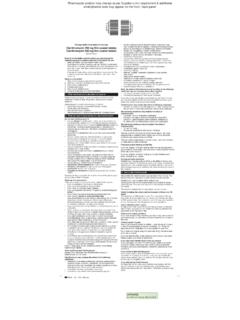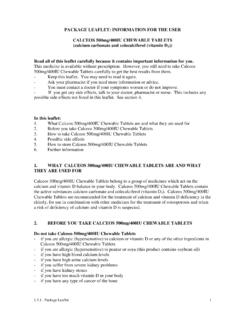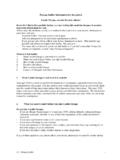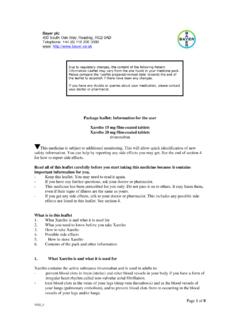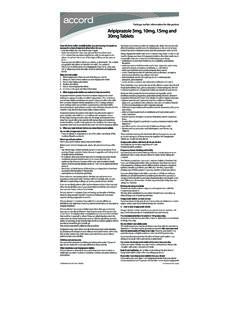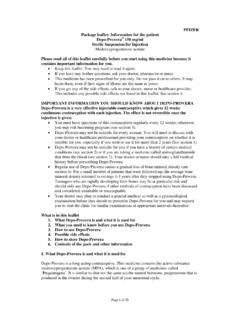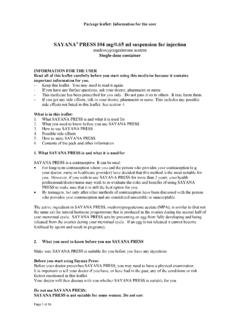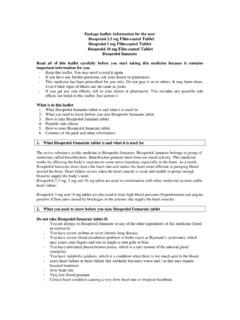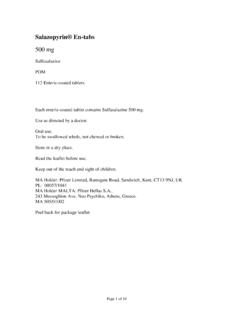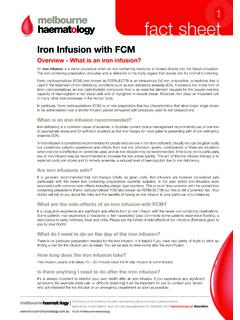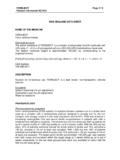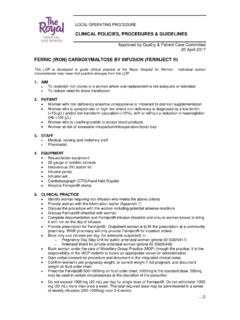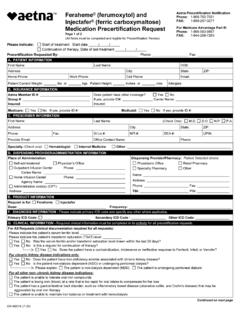Transcription of Package leaflet: Information for the patient Ferinject 50 ...
1 211126_PIL-YV007/YV080/YV013/MR/E31 T UK01 1/ 6 Package leaflet : Information for the patient Ferinject 50 mg iron /mL solution for injection/ infusion ferric carboxymaltose Read all of this leaflet carefully before you are given this medicine because it contains important Information for you. - Keep this leaflet . You may need to read it again. - If you have any further questions, ask your doctor. - If you get any side effects, talk to your doctor. This includes any possible side effects not listed in this leaflet . See section 4. What is in this leaflet 1. What Ferinject is and what it is used for 2. What you need to know before you receive Ferinject 3. How Ferinject is administered 4. Possible side effects 5. How to store Ferinject 6. Contents of the pack and other Information 1. What Ferinject is and what it is used for Ferinject is a medicine that contains iron . Medicines that contain iron are used when you do not have enough iron in your body.
2 This is called iron deficiency. Ferinject is used to treat iron deficiency when: - oral iron is not effective enough. - you cannot tolerate oral iron . - your doctor decides you need iron very quickly to build up your iron stores. The doctor will determine whether you have iron deficiency by performing a blood test. 2. What you need to know before you receive Ferinject You must not receive Ferinject - if you are allergic (hypersensitive) to ferric carboxymaltose or any of the other ingredients of this medicine (listed in section 6). - if you have experienced serious allergic (hypersensitive) reactions to other injectable iron preparations. - if you have anaemia not caused by iron deficiency. - if you have an iron overload (too much iron in your body) or disturbances in the utilisation of iron . Warnings and Precautions Talk to your doctor or nurse before receiving Ferinject : - if you have a history of medicine allergy. - if you have systemic lupus erythematosus.
3 - if you have rheumatoid arthritis. - if you have severe asthma, eczema or other allergies. - if you have an infection. - if you have liver disorders. - if you have or have had low levels of phosphate in the blood. 211126_PIL-YV007/YV080/YV013/MR/E31 T UK01 2/ 6 Ferinject should not be given to children under 14 years. Incorrect administration of Ferinject may cause leakage of the product at the administration site, which may lead to irritation of the skin and potentially long lasting brown discolouration at the site of administration. The administration must be stopped immediately when this occurs. Other medicines and Ferinject Tell your doctor if you are using, have recently used or might use any other medicines, including medicines obtained without prescription. If Ferinject is given together with oral iron preparations, then these oral preparations could be less efficient. Pregnancy There is limited data from the use of Ferinject in pregnant women.
4 It is important to tell your doctor if you are pregnant, think you may be pregnant, or are planning to have a baby. If you become pregnant during treatment, you must ask your doctor for advice. Your doctor will decide whether or not you should be given this medicine. Breast feeding If you are breast-feeding, ask your doctor for advice before you are given Ferinject . It is unlikely that Ferinject represents a risk to the nursing child. Driving and using machines Ferinject is unlikely to impair the ability to drive or operate machines. Ferinject contains sodium This medicine contains up to mg sodium (main component of cooking/table salt) in each mL of undiluted solution. This is equivalent to of the recommended maximum daily dietary intake of sodium for an adult. 3. How Ferinject is administered Your doctor will decide how much Ferinject to give you, how often you need it and for how long. Your doctor will perform a blood test to determine the dose you need.
5 Your doctor or nurse will administer Ferinject undiluted by injection, during dialysis, or diluted by infusion : - By injection, you may receive up to 20 mL of Ferinject , corresponding to 1,000 mg of iron , once a week directly into the vein. - If you are on dialysis, you may receive Ferinject during a haemodialysis session via the dialyser. - By infusion , you may receive up to 20 mL of Ferinject , corresponding to 1,000 mg of iron , once a week directly into the vein. Because Ferinject is diluted with sodium chloride solution for the infusion , it may have a volume of up to 250 mL and appear as a brown solution. Ferinject will be administered in a structure where immunoallergic events can receive appropriate and prompt treatment. You will be observed for at least 30 minutes by your doctor or nurse after each administration. If you receive more Ferinject than you should As this medicine will be given to you by trained medical staff it is not likely that you will be given too much of this medicine.
6 Overdose can cause accumulation of iron in your body. Your doctor will monitor iron parameters to avoid iron accumulation. 4. Possible side effects Like all medicines, this medicine can cause side effects, although not everybody gets them. 211126_PIL-YV007/YV080/YV013/MR/E31 T UK01 3/ 6 Serious side effects: Tell your doctor immediately if you experience any of the following signs and symptoms that may indicate a serious allergic reaction: rash ( hives), itching, difficulty breathing, wheezing and/or swelling of the lips, tongue, throat or body, and chest pain which can be a sign of a potentially serious allergic reaction called Kounis syndrome. In some patients these allergic reactions (affecting less than 1 in 1,000 people) may become severe or life-threatening (known as anaphylactoid/anaphylactic reactions) and can be associated with heart and circulation problems and loss of consciousness. Tell your doctor if you develop worsening of tiredness, muscle or bone pain (pain in your arms or legs, joints or back).
7 That may be a sign of a decrease in blood phosphorus which might cause your bones to become soft (osteomalacia). This condition may sometimes lead to bone fractures. Your doctor may also check the levels of phosphate in your blood, especially if you need a number of treatments with iron over time. Your doctor is aware of these possible side effects and will monitor you during and after the administration of Ferinject . Other side effects that you should tell your doctor about if they become serious: Common (may affect up to 1 in 10 people): headache, dizziness, feeling hot (flushing), high blood pressure, nausea and injection/ infusion site reactions (see also section 2). Uncommon ( may affect up to 1 in 100 people): numbness, tingling or prickling sensation on the skin, a change in your taste sensation, high heart rate, low blood pressure, difficulty breathing, vomiting, indigestion, stomach pain, constipation, diarrhoea, itching, hives, redness of the skin, rash, muscle-, joint -and/or back pain, pain in arms or legs, muscle spasms, fever, tiredness, chest pain, swelling of the hands and/or the feet, and chills.
8 Rare ( may affect up to 1 in 1,000 people): inflammation of a vein, a general feeling of discomfort, anxiety, fainting, feeling faint, wheeze, excessive wind (flatulence), rapid swelling of the face, mouth, tongue or throat which may cause difficulty in breathing, paleness, and skin discoloration at other areas of the body than the administration site. Not known (frequency cannot be estimated from the available data): loss of consciousness and swelling of the face. Flu-like illness (may affect up to 1 in 1,000 people) may occur a few hours to several days after injection and is typically characterised by symptoms such as high temperature, and aches and pains in muscles and joints. Some blood parameters may change temporarily, which could be detected in laboratory tests. The following change in blood parameters is common: decrease in blood phosphorus. The following changes in blood parameters are uncommon: increase in certain liver enzymes called alanine aminotransferase, aspartate aminotransferase, gamma-glutamyltransferase and alkaline phosphatase, and increase in an enzyme called lactate dehydrogenase.
9 Ask your doctor for more Information . Reporting of side effects If you get any side effects, talk to your doctor or nurse. This includes any possible side effects not listed in this leaflet . You can also report side effects directly via: Yellow Card Scheme Website: or search for MHRA Yellow Card in the Google Play or Apple App Store 211126_PIL-YV007/YV080/YV013/MR/E31 T UK01 4/ 6 By reporting side effects you can help provide more Information on the safety of this medicine. 5. How to store Ferinject Keep Ferinject out of the sight and reach of children. Do not use Ferinject after the expiry date which is stated on the label. The expiry date refers to the last day of that month. Store in the original Package in order to protect from light. Do not store above 30 C. Do not freeze. Once the Ferinject vials have been opened, they should be used immediately. After dilution with sodium chloride solution, the diluted solution should be used immediately.
10 Ferinject will normally be stored for you by your doctor or the hospital. 6. Contents of the pack and other Information What Ferinject contains The active substance is ferric carboxymaltose , an iron carbohydrate compound. The concentration of iron present in the product is 50 mg per millilitre. The other ingredients are sodium hydroxide (for pH adjustment), hydrochloric acid (for pH adjustment), and water for injection. What Ferinject looks like and contents of the pack Ferinject is a dark brown, non-transparent solution for injection/ infusion . Ferinject is supplied in glass vials containing: - 2 mL solution corresponding to 100 mg iron . Available in pack sizes of 1, 2 and 5 vials. - 10 mL solution corresponding to 500 mg iron . Available in pack sizes of 1, 2 and 5 vials. - 20 mL solution corresponding to 1,000 mg iron . Available in a pack size of 1 vial. Not all pack sizes may be marketed. Marketing Authorisation Holder and Manufacturer Vifor France 100 101 Terrasse Boieldieu Tour Franklin La D fense 8 92042 Paris La D fense Cedex France Tel.

